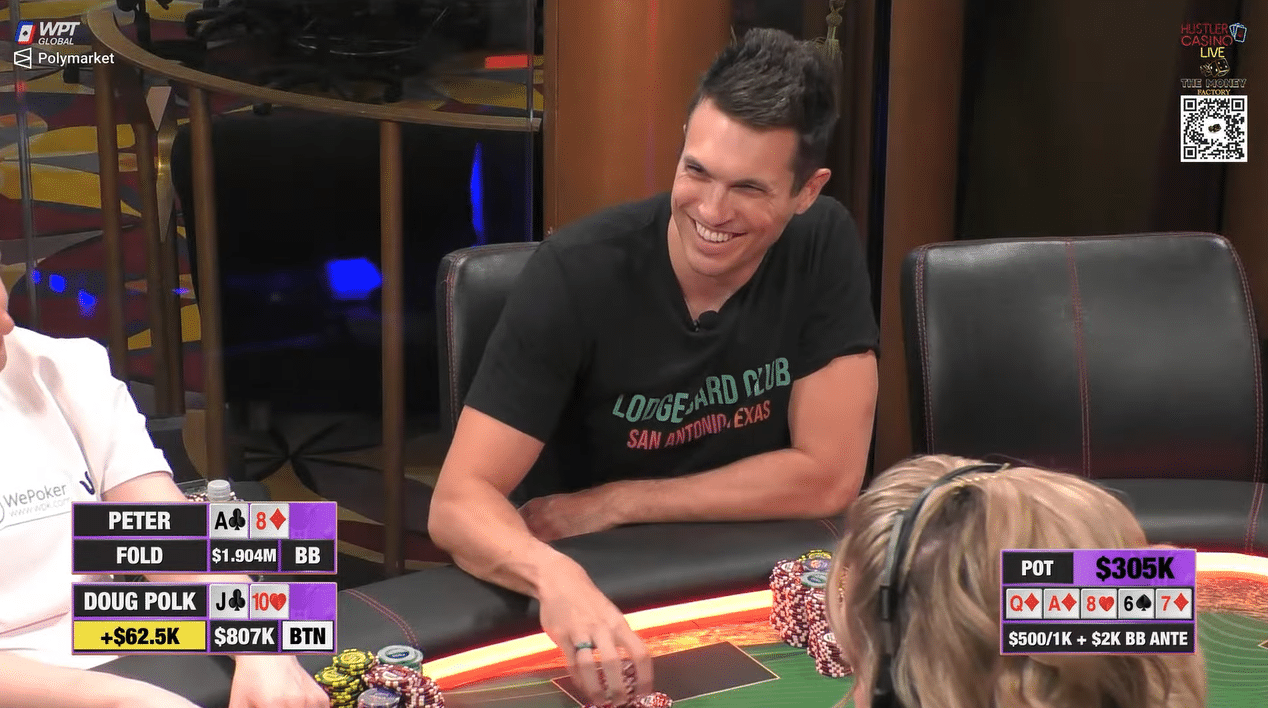Have you ever tried to bluff a guy who’s got a big stack and a ton of profit?
It’s not easy!
In today’s hand, Doug Polk attempts such a bluff against a player named Peter on Hustler Casino Live’s Million Dollar Game.
Peter had been absolutely crushing and was up $2.5 million (over the last 2 sessions) when this hand began.
The blinds are $500/$1,000 with a $2,000 big blind ante. Doug started the hand with around $750,000 and Peter covers.
Let’s jump into the action!
Note: Doug Polk is currently working on a new live poker module for members of the Upswing Lab. He plans to reveal his strategy for notable hands he’s played on stream — like a supercharged version of his Poker Hands series on YouTube. This new module is scheduled for release in August.
Want to get in the Lab for a discount before Doug’s new module goes live? Upgrade your skills and save 33% during the Vegas Winners Sale!
But hurry because this sale expires in less than a week. Learn more now!
Preflop Action
Tom Dwan raises to $3,000 from the Cutoff with As 3h. Doug calls with Jc Th on the Button. Peter defends the Big Blind with Ac 8d.
Simple Preflop Analysis
Tom makes an okay raise with Ace-Three offsuit. It is a mediocre hand that is right on the borderline between raising and folding from his position. If there was no ante and/or high rake, this would be a clear fold.
Doug makes a good call with Jack-Ten offsuit. It’s not a particularly strong hand. But given the large ante and the fact that he is in position, it is strong enough to call. Again, this would be a clear fold if there was no ante.
(The ante and lack of rake really incentivizes looser play!)
Peter makes a good call with Ace-Eight offsuit. He is getting a great price to call against two wide ranges and is closing the action from the Big Blind.
Advanced Preflop Analysis
The key factor in this hand is the presence of a large big blind ante, which incentives all players to play loose.
Ace-Three offsuit is a borderline hand for Tom to raise. He should be raising with around the top 35-40% of starting hands. Both raising and folding are reasonable options.
Doug should be playing a wide range here and his call with Jack-Ten offsuit is good. His range should be roughly the top 25-30% of hands, mixing evenly between 3-betting and cold-calling (except for premiums like Pocket Jacks or better, Ace-King, and Ace-Queen suited, with which he should always 3-bet).
Peter can continue with an extremely wide range and his call with Ace-Eight offsuit is good. He is closing the action with a lot of dead money in the pot. So his defending range should probably go as wide as offsuit gappers (like 53-offsuit, 64-offsuit, 75-offsuit), any Ax offsuit, all suited hands, and some hands like K8-offsuit, Q9-offsuit, and J9-offsuit.
Flop Action
The flop comes Ad [Qd] [8h] and the pot is $11,500.
Peter checks. Tom checks. Doug bets $5,000. Peter raises to $17,000. Tom folds. Doug calls.
Simple Flop Analysis
An action flop gives Peter two pair, Tom top pair, and Doug a double gutshot straight draw.
Even though Peter flopped two pair, he should still check to the preflop raiser (Tom). His hand plays best as a check-raise.
Tom makes a good decision to check. His top pair is not strong enough to bet for value in a multiway pot.
Doug’s bet with his straight draw is a solid play. He can get stronger hands to fold and, if called, he has a chance to improve to a straight on a 9x or Kx.
Faced with this bet, Peter makes a good check-raise with two pair. He has an extremely strong hand that wants to build the pot as fast as possible.
Tom makes the correct fold. His hand is too weak to put more money into the pot vs two players who have both shown strength.
Doug makes a good call. He knows he is almost certainly behind at the moment. But plenty of turn/river cards can improve his hand. Plus, he may end up with a profitable bluff opportunity on a later street.
Advanced Flop Analysis
There a lot of decisions in this hand so I’ll break them down one by one.
On this dynamic flop, Peter has two pair, Tom has top pair weak kicker, and Doug has a double gutshot straight draw.
Checking over to Doug is the right strategy for both Peter and Tom. Doug’s range is the tightest and thus has the highest concentration of nutted hands.
Doug should bet with a polarized range because he is faced with 2 opponents who can both hold very strong hands. Therefore, Doug should c-bet for value with a tighter range, and construct an appropriately smaller bluffing range. Jack-Ten offsuit is a double gutter that fits this role perfectly. It has no showdown value and great potential to improve to the nuts.
As far as sizing goes, Doug’s is very good. He is putting just enough pressure on Peter’s Qx and weaker hands, while not risking too much. Betting smaller would give away too much equity to weaker hands by allowing both Peter and Tom to defend more freely. Betting bigger would start to hinder his ability to extract value with his strong hands.
Peter has a monster hand that he should be looking to check-raise for value (at least some of the time). His sizing is good, putting pressure on Doug’s weakest draws.
Tom makes a good laydown here. Peter is representing a two pair or better for value, which puts his hand in a pure bluff-catcher scenario. Plus Doug is still left to act with a ton of good hands in his range.
Doug’s call is very good. He has a lot of equity to improve to the nuts and is in position.
Turn Action
The turn comes the 6s, making the board Ad Qd 8h 6s. The pot is $45,500.
Peter bets $37,000. Doug calls.
Simple Turn Analysis
The turn 6s doesn’t change anything since no draws complete.
Peter makes a good decision to bet with his two pair (but he could also look to check-raise again). For sizing, he could also consider an overbet since there are so many potential draws on the board.
Doug’s straight draw is right on the borderline between call and fold. He’s not getting an amazing price to call, but he’s in position and may get paid off if he hits a King or a Nine on the river.
Advanced Turn Analysis
Neither player’s ranges improve on the the 6s turn.
Peter’s Ace-Eight is a great candidate for barreling or check-raising for value. It all comes down to a few factors:
- How often does he think Doug will stab with his draws? (the more often Doug stabs, the more trapping makes sense)
- How well does he think he can play on the river after Doug calls his bet? (the more accurately he thinks he can play, the better it is to barrel)
- The deeper the stacks are, the more often he should bet.*
*This happens because there is a larger incentive to build the pot right away to get the stacks in and to thin out Doug’s draws.
Given the extremely large stack-to-pot ratio (SPR), going for a turn overbet at a high frequency is the better play overall. This line gets him the most amount of value and clarity on the river.
Doug’s Jack-Ten is very close to breaking even as a call against a balanced betting range. It has good properties for calling as it unblocks Peter’s flush draws. This is the type of holding that you should randomize between calling and folding against unknown opponents.
River Action
The river is a flush-completing [7d], making the board Ad Qd 8h 6s 7d. The pot is $120,000.
Peter checks. Doug overbets $185,000.
Simple River Analysis
The [7d] is an action card as both players can now have flushes in their range.
Peter should look to value bet with a small size. However, it’s hard to fault him for checking on this scary river.
Doug makes a great decision to overbet bluff. He is targeting folds from the exact types of hand that Peter has.
Peter can fold or call facing this massive bet. It all comes down to how often he thinks Doug will be bluffing.
Advanced River Analysis
The river [7d] changes everything as both players can have flushes.
Peter should make a thin value bet with his two pair (especially because he holds the 8d). In theory, he’ll have very few bluffs here which forces him to use a smaller size. By checking, he allows Doug to create a polarized betting range that would make his two pair indifferent between calling and folding.
Doug makes a great overbet, correctly recognizing that Peter is likely to be capped at two pair. His overbet range consists of sets and flushes for value and missed straight draws for bluffs.
Faced with this overbet, Peter decides that Doug is likely under-bluffing (or simply didn’t feel like risking this much money). He elects to fold his bluff-catcher despite having a good blocker card to Doug’s flushes.
Results
Peter folds and Doug drags the $120,000 pot as he gleefully flips his hand face up.

The smile of a man who just bluffed a rich guy
Final Thoughts
Wow! What a sick hand!
That’s all for this breakdown! I hope you enjoyed it and that you learned something new from it! Do you think Peter made a good fold on the river? Let me know in the comment section down below!
Till’ next time, good luck, grinders!
(Remember, Doug’s new live poker lesson drops next month in the Upswing Lab. Be sure to sign up before then!)
The post Doug Polk Tries to Bluff a Guy Who’s Up $2.5 Million (Hustler Casino Live Analysis) appeared first on Upswing Poker.







